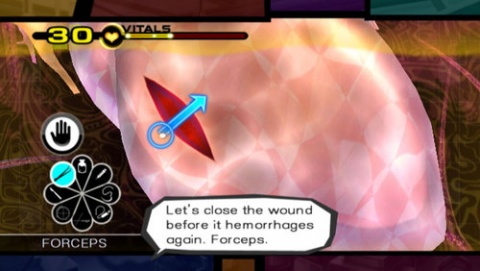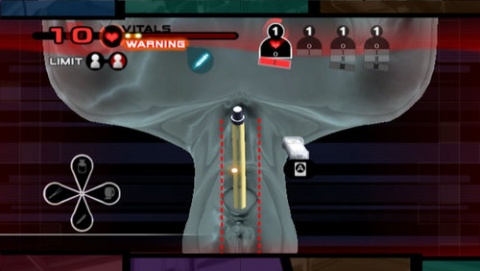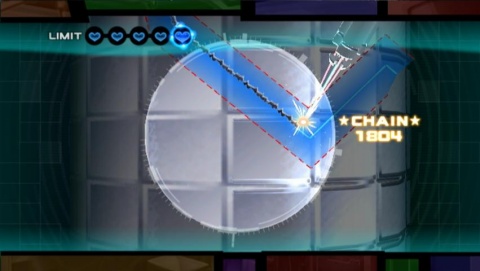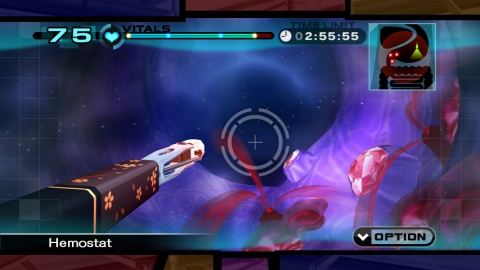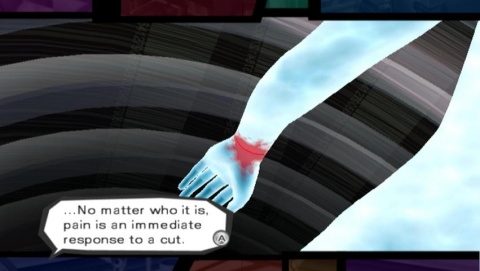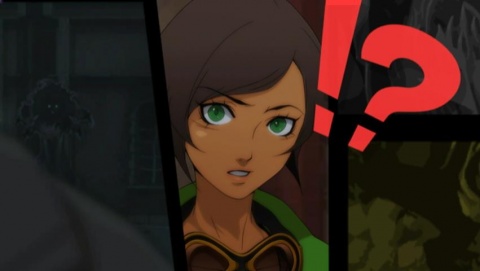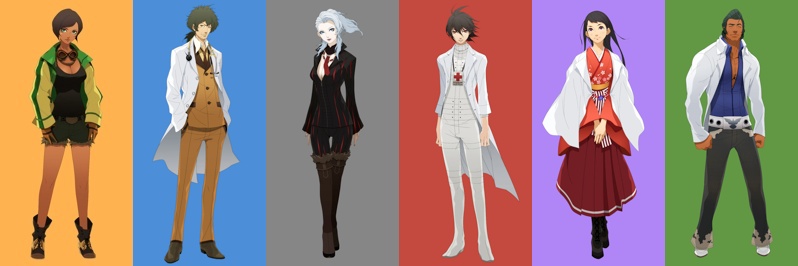Trauma Team
| Trauma Team | |
|---|---|
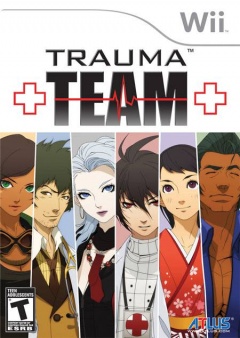 |
|
| Platforms | Wii |
| Genre | Diagnosis Inconclusive |
| MtAMinutes to Action | 10 |
| Keep Playing? | Yes |
| Buy from Amazon | |
Classifying video games into genres can be a tricky ordeal. For example, let's look at Fable. It's a role-playing game because it uses dynamic statistics as modifiers to its core mechanics, right? But one of the traditional indicators of an RPG video game is that it plays out with little regard to nuanced player input: its action is menu driven and often turn based. Fable's real-time combat, on the other hand, relies on player dexterity (as in an Action game) as much as it does the quantifications of the battle engine. So, in our propensity to create subgenres when things don't fit so neatly, we just call it an Action RPG. However, it's hard to be satisfied with this conclusion when one could replace every instance of "Fable" in this paragraph with "BioShock," "Mass Effect," or even "Star Ocean" and it would be no less true, even if all of these games feel completely different in once you get your hands on the controller.
Trauma Center: Under the Knife arrived on the scene in the Nintendo DS launch window, requiring players to perform lightspeed surgeries using a variety of medical instruments through the handheld's touch screen. Ignoring the dearth of surgery games (or even touch screen games) to use as precedent, Trauma Center was still very tough to define. Can we really use the catchall Simulation genre for a game where heart surgery lasts all of a minute and Space Invaders can be found in the patient's lungs? Is it part visual novel merely because operations are bookended and pervaded by character portraits and dialogue? Not content to let us try and figure it out after four games, Atlus' fifth title in the franchise, Trauma Team, complicates things further by providing six different scenarios to play through, each with its own exploration within (and sometimes a bit outside) the traditional Trauma Center structure.
Okay, so I don't really know what to call it. A more important concern, though, is whether or not it's fun. So how did my first hour go with this...whatever it is?
Minute by Minute
(minutes are in bold)
00 - New Game. "Resident" difficulty is the new medium. "Any similarities with real life situations are coincidental."
01
- A flock of monarch butterflies dance above an enormous field of
flowers. There is a girl sleeping in the field. Or is she dead?
Elsewhere: an ambulance speeds through city streets, passing people by.
It says "Resurgam" on the side.
02 - The character select screen
shows up. Six vertical lines appear, each representing one playable doctor's plotline. Some doctors' operations take place before others
chronologically, but I can play them in any order I want.
03 - I can also change the difficulty for each doctor and chapter at any time. Neat.
04
- I'll choose CR-S01 (Surgery) first. A cutscene shows that he is locked in a
maximum-security prison. He apparently has a 250 year sentence.
05
- A G-Man orders the soldiers to open the door. The prisoner is chained
and masked. The G-Man offers a reduced sentence if the prisoner operates
on somebody.
06 - And I'm back to the stage select. I guess that
was just an Event to watch. The next chapter is an Operation, so let's
check that out.
07 - A prison van pulls up to a hospital,
Resurgam First Care, and the prisoner walks out, unmasked. He has red
eyes and is dressed in all white. Apparently he'll get five years off
his sentence if he operates.
08 - A large, tan man in a lab coat
approaches the prisoner. His name is Hank Freebird, and he'll be
assisting. Hank seems friendly. He briefs the prisoner-surgeon with some
medical jargon. The prisoner seems to genuinely want to help people. I bet he was framed for whatever he did.
09
- I'm to treat a "dilated cardiomyopathy," whatever that means. There's
a 2-player option if you want to co-operate with a friend. The rules
here are pretty simple: if the patient's vitals drop to 0, the operation
is a failure.
10 - And the operation begins. The mysterious
"green medicine" from other games returns. It inexplicably raises the
patient's "vitals." I pump him full of green medicine and open up his
chest with the scalpel. There is a tutorial for every tool and
procedure.
11 - I'm using the ultrasound to find infected areas.
Once found, I inject some antiviral drugs, incise the area, drain the
infection, and seal the incision with forseps and suturing. Every tool
is selected with the control stick on the nunchuk in a "weapon wheel"
style.
12 - A second infection is found with the ultrasound, but
apparently the rest won't be able to be found with it. Now I'm palpating
the region directly with my "hand" tool to find more infections.
13
- I'm not sure what I'm looking for here...when I point on an area,
little waves come out of the hand. What am I supposed to be looking for?
Maybe I'm supposed to have the vibration function to detect these
things...
14 - I've found an abnormal area. The controller rumbles
differently and the waves on-screen change when one is found. I perform
the procedure a few more times to disinfect the areas.
15 - Guess
I've found all the infections, so I seal the guy up with some
disinfectant, sutures, and bandages. My assistant Hank is impressed with
my work. Operation successful! I'm graded on my work. Apparently each
treatment was graded (Cool, good, or bad) and there are some bonus
achievements. I get an S rank for the operation.
16 - Cutscene: Hank congratulates the modest prisoner-surgeon, who is then transported back to his cell via the prison van.
17 - The next chapter for CR-S01 is available, but I'll skip over to a different doctor. The next one over is Maria Torres (First Response).
18
- Cutscene: She steps out of the shower. Obligatory cleavage shot. The phone
rings. The Chief calls to inform Maria of a fire. She isn't happy, since
she's off duty. The garage door opens and she speeds away on her
motorcycle.
19 - Cutscene: There's an ambulance at the fire.
Maria asks a paramedic on the scene what happened, then rushes into the
fire to find survivors.
20 - Several people need treatment in this operation. Co-op is available here as well.
21
- The operation begins. I am dealing with several people at once. If I
let too many of them die, I fail the operation. I use some gauze to
absorb some blood and anesthetize some burns with gel, then cover them
with gauze and tape.
22 - Treating more burns on the abdomen,
then looking at the patient's arm. It's got some burns, but he seems like he'll be alright for a
bit, so I shift my attention to another patient.
23 - She has
multiple burns, so I treat them with gel and gauze. She begins to
convulse, though, and goes into cardiac arrest. I perform chest
compressions to get her heartbeat back, then secure an airway with a
laryngeal mask. This patient has stabilized, so I'm done working here.
24
- I go back to the boy's arm and heal the burns there. Maria thinks a
blood transfusion is also a good idea, so I work a needle in his arm and
wrap bandages around it.
25 - The boy is stabilized and taken
away. Apparently that's it, and I'm done with the operation. I got a B
rank this mission. Guess I missed a few things.
26 - Cutscene: One of
the paramedics chews out Maria for ordering people around and says she's
a nuisance. Maria starts to bark back, but sees a hallucination of the
sleeping/dead girl from the opening cutscene. Wait, what? Anyway, she
snaps out of it, smacks the guy in the face, and speeds away on her
motorcycle. I bet she's got a troubled past, hence her prickly demeanor.
27 - Well that one's done with. Let's try another
character. The next one is Hank Freebird (Orthopedics). He's the guy who assisted the first
doctor in his operation. Apparently this Event happens a while before then.
28
- A man with a gun is holding up a grocery store. "Not so fast,
criminal!" A superhero, Captain Eagle, shows up. He is very corny, but
manages to uppercut the gunman right through the ceiling. Captain Eagle throws
some change onto the counter to "cover the damages." I don't think
that'll quite do it...
29 - Cutscene: A shaggy-looking doctor is
standing outside Resurgam First Care. Captain Eagle flies in behind him
and falls into the dumpster. Hank Freebird emerges, saying he tripped
and fell in. The doctor gives Hank a file, and tells him to operate.
30 - Apparently the girl has Plummer's Disease. The shaggy-looking doctor will assist the operation. Again, co-op is available.
31
- Orthopedics rules: Miss too many times and you fail. It looks like
these operations aren't timed, and instead focus on precision and
minimizing mistakes. I don't even need to use the nunchuk, so I hold the
Wii remote in both hands for extra stability.
32 - I have to make an excision to remove an infected area. It's as simple as tracing a curving line.
33
- The next infected area is much larger, so the screen has to scroll
while I'm cutting. It's sort of difficult to stay inside the guideline
while the screen is moving like that. Still, I haven't made any mistakes
yet.
34 - A combo chain builds as I perform the procedure. As
the chain grows, I get more points. Anyway, I excised the last infected
area, so I use a stapler to close the patient up.
35 - Operation successful: Rank S.
36
- The two doctors are in the showers. The shaggy-looking doctor is
smoking in the shower. Hank is puzzled, but the man compares the
cigarette to an oxygen mask. Guess he really likes cigarettes.
37
- A radio broadcast says a drug cartel leader, Theodore Gacy, is
arriving in America. The smoking doctor asks Hank if he'd like to get a
drink later, but Hank is missing. Elsewhere: the cartel leader, eager to
begin selling in America, is approached by Captain Eagle. His cronies pull pistols.
38 -
"Guns are only for murdering people!" Captain Eagle tosses a car at the
man, then flees the scene as the police show up. The cops immediately
put Theodore Gacy under arrest. Did he do anything? I guess he did pull a
gun, but a crazy man in a superhero outfit did confront him, it was self defense! I bet some tragic loss is what caused Hank to become a superhero.
39 - Anyway, the next character is Tomoe Tachibana (Endoscopy). A
butler approaches a hot spring in a Japanese garden. Tomoe is taking a
bath in the hot spring. She tells the butler, Hanzou, to prepare for her departure to
America.
40 - She talks of honor and gods and such, then puts on a
kimono and a lab coat. A line of servants bow to her as she walks down
the hall.
41 - Maria, the First Response medic I played as
earlier, arrives at the hospital via helicopter. Tomoe says that
Gabe's son is having an ulcer treatment today. Maria offers her help,
and though Tomoe initially refuses, she gives in as Maria asserts her assistance.
42 - Tomoe's
butler, Hanzou, is ordered to prepare for the operation. Wait, what!? He
just disappeared! Is he a ninja? Is he a ninja-butler-nurse? He brings
Tomoe's personal endoscope to the operation room. It is gaudy, but Tomoe
writes it off as merely being top-of-the-line.
43 - Apparently
the boy's parents haven't shown up for the operation. His mom is busy,
and his dad works here but doesn't feel like showing up. I'm to treat
the ulcers in his gastric wall. Co-op is available here as well.
44
- The operation begins. Apparently I have to push the endoscope through
the intestines by holding the A button and B trigger together and
pushing the Wii remote towards the screen. Direction is controlled by
the analog stick. I'm not supposed to hit the walls.
45 - I move
forward through the intestines and come upon the first infected area. I
use a drain to absorb a pool of blood in the intestinal wall.
46
- Still just pushing through the intestines. This is kind of tiring, I
keep having to push the Wii remote at the television to proceed.
47
- I've found a hemmorhaging area, leaking blood. I use the hemostatic
forseps to close and cauterize the hemmorhaging. I can't hold on too
long or I could harm the intestines.
48 - I'm not liking this
slower-paced operation style. Choosing tools and moving through the
intestines are all kind of clumsy as well, compared to the weapon wheels used in other surgeries. I've come upon an ulcer
and inject some medicine into it. I have to inject the right amount, and
no more.
49 - A radar in the corner of the screen shows the
location of nearby infections. Apparently not all ulcers can be found by
the camera without being sprayed first, so I use the radar to find
areas to spray.
50 - I've pushed all the way up into the stomach
now, and am finding more infections. Draining blood, cauterizing
hemmorhages, injecting medicine...
51 - I found all the visible infections, now I have to spray for hidden infections using the radar. Found some more...
52
- I've cured all the infected areas, and the operation is a success.
Rank: C. Guess I took too long and made too many mistakes. Oh well,
still finished it.
53 - Cutscene: Maria is overly enthusiastic
about the completed operation. She likes helping kids, and mentions she
was raised at an orphanage. Troubled past confirmed? Tomoe mentions that her mother is dead and
she had a falling out with her dad. Awkward! I bet her dad wishes she were a ninja or something, rather than a doctor. This is so familiar...
54 - The two doctors and a few assistants all go out to eat, at Maria's forceful suggestion. Yay.
55
- The next doctor is Gabriel Cunningham (Diagnostics). He's the lazy doctor from earlier
who had a cigarette. His son is apparently the kid I just operated on. Guess this guy doesn't put much stock in family, he didn't even show up for the operation. His story starts long before all the other doctors I've controlled thus
far.
56 - Cutscene: He has a dream about a particularly busy day
at the hospital, and wakes up when the phone rings. He doesn't bother
answering. It's his wife, saying she'll come pick up their son's stuff.
Guess the family's split up. Gabe doesn't seem too interested, yawning
his way out the door. I bet he's secretly torn apart by his conflicting obligations to his patients and his family.
57 - Cutscene: The chief brings in a large computer. It's called the "RONI" system. Apparently it's Gabe's new "partner."
58
- Apparently the computer is built to help diagnosticians, like Gabe.
It has a disease database and stores symptoms as they're found. Gabe
accepts it with plenty of sarcasm.
59 - "Good morning, Dr.
Cunningham." Looks like the computer talks, too. It mistakes Gabe's
exasperated sigh for a symptom of cardiac neurosis and recommends
tranquilizers. Gabe tells RONI not to talk anymore until asked to.
60
- The briefing says that the patient has had difficulty breathing and
some other symptoms. Guess I'm supposed to sort out what the problem is.
Dr. Cunningham's diagnostics segment had me picking out symptoms of illness from patient examinations, blood test results and x-rays, and then applying each finding to hypothetical diagnoses. Each activity boiled down to "what is wrong with this picture?" but there was enough variety that the case never wore thin in its rather lengthy thirty minute duration. Diagnosis also seems to be the game's primary source of humor: Dr. Cunningham's exchanges with computer assistant RONI delivered some smiles, and I couldn't help but laugh at the questionable thoughts that ran through his mind while examining his schoolgirl patient. Anybody who's spent time in an Ace Attorney courtroom will feel right at home with the mood and progression here.
Meanwhile, Naomi Kimishima (Forensics) delivered the investigation half of the Ace Attorney formula. Trauma series veterans may recognize Dr. Kimishima as a surgeon from Second Opinion. In Trauma Team, she performs forensic investigations with her assistant, an FBI agent referred to as "Little Guy." Activities included examining the deceased and their personal effects for clues, listening for key statements in witness interviews, scouring crime scenes for objects of interest, and combining facts of the case -- represented by cards -- into logical deductions that eventually reveal the true cause of death. It was a greater challenge than diagnosis and rivaled some of the more brain-teasing Phoenix Wright cases, but mostly took a more somber tone. Some of the revelations were actually a bit grisly, though nothing on-screen ever appeared graphic. This was the longest segment, lasting nearly an hour on its own.
First Hour Summary
Minutes to Action: 10
What
I liked: General Surgery, First Response, and Orthopedics. Each is an
adaptation of the series trademark gameplay with its own wrinkles.
Diagnostics and Forensics are also a nice bonus thus far.
What I
didn't like: Endoscopy wasn't that bad, but it's definitely my least
favorite at this point. Pushing the Wii remote at the screen to move the
camera forward gets tiring quickly, and the tool selection and
manipulation aren't nearly as intuitive as the other operations.
Video:
These guts could pass for bubblegum with their bright, clean colors and
plastic appearance. I'm usually pretty squeamish when it comes to the
inner workings of human beings, but I have no problem cutting into a
beating heart in the Trauma Center series. The living-comic style
cutscenes look about as good as talking cardboard cutouts can, but that
only goes so far.
Audio: Voice acting ranges from decent to
annoying. The tense tunes that accompany surgery are mood-appropriate,
as is the easygoing waiting room soundtrack that plays during cutscenes
and diagnostics/forensics.
Story: Atlus preambles the instruction
manual with the claim that Trauma Team is a more "realistic" surgery
game than its predecessors. That sort of falls apart since the playable
characters are an amnesiac sentenced to 250 years in prison, an EMT with
prophetic hallucinations, a doctor who moonlights as a superhero, a
ninja princess with gold-adorned medical equipment, a sarcastic deadbeat
dad with a computer sidekick, and a terminally-ill forensics expert who
gets phone calls from dead people.
Gameplay: Surgery, First
Response, and Orthopedics all have that fast and precise, arcadey feel
from Trauma Centers past. Endoscopy has a slower pace and clumsier
controls. Diagnostics and Forensics play out like point-and-click
adventures, specifically giving off a Phoenix Wright vibe.
Challenge:
Your assistant will always tell you how to proceed with the operation,
so the challenge is in speed and accuracy. Things are definitely easier
this time around than in previous Trauma Center games, but blindly
stabbing into the patient will get you nowhere.
Pacing: It's nice
to be able to switch between all the different specializations at any
time. First Response feels appropriately rushed, the other surgeries
have some time-critical elements, and diagnostics and forensics offer
lengthy breathers between the bite-sized pressures of operation.
Fun
Factor: Players are bound to play favorites with the four different
takes on surgery, and point-and-click lovers will enjoy the other two
offerings.
Would I keep playing? Yes. I'd rather not go through
endoscopy again, and I'm only lukewarm to orthopedics, but the rest of
the suite was enjoyable enough.
Words from beyond the First Hour:
I've finished the story mode of Trauma Team. All in all, the first case
of each discipline provides an apt preview for the rest of the
experience.
As far as I'm concerned, Atlus' efforts to shake up
the franchise bring an equal number of positives and negatives to the
operating table. I really enjoyed the new Forensics and Diagnostics
portions of the game, but taking a field trip into the rectum with
Endoscopy is about as fun as it sounds. The added variety provides
plenty of relief from heart-pounding matters of life and death, but the
handful of operations in each discipline never really test your surgical
prowess as they did in games past. Finally, the move away from
ridiculous fictional bio-terrorism provided a slightly more believable
foe, but the character-driven plot often falls flat with awkward
Japanese melodrama typical of the medium.
Despite its multiple
personalities, I think Trauma Team best serves as an introduction to the
series. Those who have finished previous Trauma games will probably be
disappointed in just how easy it is to wipe out this world-threatening
epidemic, though of course there's always the chase for higher ranks, a
tougher difficulty level, and extra challenges specific to each case and
operation. Anybody using the Wii Remote as forceps for the first time,
however, will find it an accessible gateway to a franchise that occupies
its very own genre. Surprisingly, the game can be given equal
recommendation to fans of point-and-click adventure mechanics. The
Forensics and Diagnostics portions alone probably could have been sold
as their own game, as they make up the bulk of the 20+ hour time
investment. The discounted price ($40 at launch, and less now) is added
incentive for the curious to grab their scalpels and incise one of this
generation's indefinable niche darlings for the first time.

